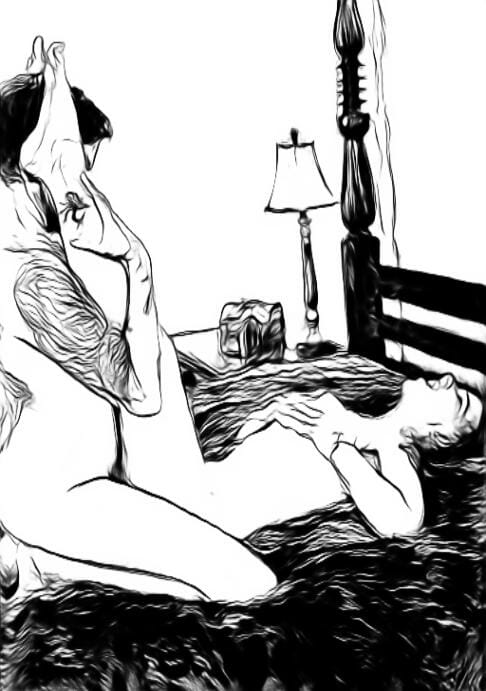It’s well-known that couples in long-term relationships often struggle with mismatched libidos. In one partner, the sex drive is high, and they have an insatiable appetite for passion and physical intimacy. Meanwhile, their other half may not be as eager to jump into bed or engage in sexual activity. This can become incredibly frustrating, leaving both partners unheard, confused, and unfulfilled.
But there is hope! A mismatch in libido doesn’t spell doom for your relationship if you take the time to understand each other’s needs and make adjustments accordingly. When it comes to dealing with mismatched libidos within a relationship, communication is critical. Learning to communicate about sex without judgment or shame effectively will help navigate this sensitive subject successfully so that both partners feel satisfied and loved.
So if you’re struggling with misaligned desires when it comes to sex, then don’t worry – we’ve got your back! The following article will provide helpful tips on dealing with mismatched libidos in your relationship so you can move forward together feeling connected, supported, and respected.

Mismatched Libidos in a Relationship
Definition Of Libido
Libido is a person’s sex drive and can be influenced by many factors, such as hormones, stress levels, physical health, mental state, self-image, relationship dynamics, etc. In general terms, libido is the energy or desire that motivates someone to pursue sexual pleasure. It’s important to remember that everyone experiences libido differently; there isn’t one “normal” level of passion for all people.
However, things get tricky when it comes to relationships where two partners have different levels of libido. This mismatch in libidos can create tension between partners if they need to be able to communicate effectively about their needs and desires. The good news is that mismatched libidos can be okay with open communication and understanding.
It helps to understand what might be causing the discrepancy to address the issue better. That brings us to our next section – causes of libido discrepancies.
Causes Of Libido Discrepancies
It’s important to note that various factors can cause mismatched libidos. It could be due to physical issues, such as hormonal imbalances or illnesses; mental health issues, like depression, anxiety, or PTSD; lifestyle changes, like stress levels or diet; and even relationship dynamics, such as trust, communication styles, and intimacy level.
In addition, there may also be cultural and societal expectations at play when it comes to sex drives. For example, men are often expected to have higher sex drives than women. At the same time, specific relationship roles (e.g., the provider vs. nurturer) can create power dynamics that affect both partners’ desires for physical pleasure. So it’s essential to consider all these possible causes before deciding who is “right” or “wrong.”
All this being said, if you’re experiencing discrepancies in libido with your partner – large or small – don’t despair! There are ways to work through this issue effectively as long as both parties are willing to communicate openly and honestly about their needs and feelings. With that in mind, let’s discuss some signs of libido issues in a relationship.
Signs Of Libido Issues In A Relationship
One of the most common signs that a couple may have mismatched libidos is when one partner starts to feel increasingly frustrated and resentful. They may feel rejected or unappreciated if their partner isn’t as interested in sex, leading to arguments over why they don’t want it more often. Additionally, there may be a lack of physical intimacy, even outside of sexual activity – such as cuddling, kissing, or holding hands – because one person’s desire for these activities has diminished.
Another sign could be if one partner expresses discomfort with certain types of sexual behavior or suggests changing how things are typically done to make them more enjoyable. This could mean anything from introducing new toys into the bedroom to taking breaks during intercourse so both partners can re-focus on pleasure rather than just performance.
Finally, communication about sex (or lack thereof) becomes strained at best and non-existent at worst due to feelings of shame or guilt about not wanting it enough. These issues tend to come out indirectly through criticism and passive-aggressive comments instead of being discussed openly and constructively. With all this considered, let’s look into some strategies for dealing with the mismatch between libidos.
Communication Strategies
Mismatched libidos can be tricky and sensitive to navigate in a relationship. Still, with proper communication and understanding, finding solutions that work for both partners is possible. The key is approaching the conversation with an open mind and respecting each other’s needs.
The first step is to discuss what feels good and what doesn’t. Having an honest dialogue about desires, boundaries, and expectations is essential – all without judgment or blame. This allows each partner to express their feelings openly and feel heard by the other person. Additionally, it helps create a mutual understanding of what makes sex enjoyable for everyone involved so you can find ways to compromise when needed.
It’s also beneficial to discuss any underlying issues that may be causing the mismatch, such as stress, physical health problems, past trauma, or even boredom in the bedroom due to a lack of variety. By discussing these topics together, couples can develop creative solutions that address their individual needs while still keeping intimacy alive.
Ways To Improve Intimacy
In addition to open communication, there are a few other ways couples can work together to improve intimacy and bridge the gap between their libidos. Setting aside time for sexual activities, even just cuddling or kissing, is one way to keep the physical connection alive in the relationship. It also allows each partner to explore what feels good without pressure on performance.
Exploring new things in the bedroom, like different positions, toys, techniques, or fantasies, is another excellent option for increasing pleasure and reigniting passion. This may require some research on both partners’ parts, but understanding how sex works physically and emotionally can be immensely helpful when trying to find compromises that make everyone feel satisfied.
Finally, looking outside the bedroom for connection sources, such as shared hobbies or interests, can also help foster intimacy between partners. Taking walks together or planning date nights can remind them why they fell in love in the first place and eliminate any resentment that might have been built up over mismatched libidos. With these strategies in mind, couples should be able to approach this issue with empathy and patience while finding solutions that meet everyone’s needs.
Suppose all else fails and disagreements remain unresolved. In that case, a therapist’s professional help may be necessary to move toward a healthier dynamic within the relationship.
Seeking Professional Help
When communication and compromise fail to bridge the gap between mismatched libidos, seeking outside help can be an excellent way for couples to gain insight into this issue. A therapist can provide an objective perspective on the situation, helping partners identify their needs and those of the other person. They can also explore any underlying causes that may contribute to differences in sexual desire, such as past trauma or relationship issues.
Therapy sessions often focus on finding solutions that work best for both parties while respecting each partner’s wants and needs. However, it is essential to remember that therapy alone isn’t enough; it requires both sides to make changes for things to improve. This could involve taking responsibility for one’s actions and learning to communicate more effectively to reach an agreement without arguing or feeling frustrated.
In some cases, even after counseling has been sought, mismatched libidos remain unresolved, which means couples must look towards long-term strategies for resolution.
Long-Term Strategies For Resolution
As a long-term strategy, couples can start by exploring different approaches to intimacy and sexual desire. This could include setting aside time for date nights or finding activities that both partners enjoy doing together. It is also important to remember that sex isn’t the only way of expressing love; there are other ways of connecting, such as cuddling, kissing, massage, and simply spending quality time with each other.
The focus should be on understanding the needs of one another and creating a safe space where you can openly talk about anything without fear of judgment. Showing compassion and empathy towards each other’s feelings will help build trust between partners, which leads to greater satisfaction within the relationship overall.
It’s essential to remember that relationships take work and compromise from both sides if they last over the long haul. Working together to find solutions that meet everyone’s needs is critical when dealing with mismatched libidos – whether this means taking turns initiating sex or reevaluating expectations around performance – communication is essential. Couples can reach a place that works for them with patience, understanding, and open dialogue.
Frequently Asked Questions
What If I Am Not Comfortable Talking About My Libido Issues With My Partner?
Discussing libido issues with a partner can be challenging, especially when those levels are mismatched. This can lead to feelings of shame and awkwardness as you may feel like your needs aren’t being met or that you’re not meeting your partner’s expectations. It’s important to remember that it’s okay to have different libidos in a relationship; an open dialogue about this issue is essential for both partners’ emotional well-being.
Suppose you don’t feel comfortable discussing these issues with your partner. In that case, the best way forward is to start by talking to someone who isn’t directly involved in the situation, such as a close friend or professional counselor. Having another person there can provide much-needed perspective on approaching the conversation without feeling overwhelmed or judged. Additionally, researching what methods work best for addressing disparities in libido could give you more insight into where your and your partner’s differences lie and how they might meet each other halfway.
It could also help to take some time alone before jumping right into the discussion so that you can reflect on what makes you uncomfortable and develop strategies for navigating the conversation more successfully. Being honest and straightforward while expressing understanding towards one another will go a long way toward resolving any conflict over differing libidos in the relationship.
How Can I Help My Partner Understand My Feelings About Having A Mismatched Libido?
When it comes to having a mismatched libido in a relationship, it can be difficult for one partner to explain their feelings about the situation to the other. This is especially true if they are uncomfortable discussing issues related to their libido. But there are ways that partners can help each other understand and empathize with how they feel.
One way is by creating an environment where both partners can talk openly and honestly without fear of judgment or criticism. Open communication will allow them to express their needs, desires, and concerns more freely. Additionally, being supportive and understanding during these conversations will help set the tone of respect between both parties, which could lead to better outcomes down the line.
Another important thing that couples should consider when dealing with a mismatch in libidos is exploring activities outside of sex that may bring them closer together, such as taking walks or going on dates. Doing something enjoyable together can remove some pressure from feeling like you need to “perform” sexually and instead focus on building strong emotional connections within your relationship.
No matter what strategies work best for you, it’s essential for couples with mismatched libidos to remember that communicating your feelings clearly and respectfully is vital for ensuring both people’s needs are met and respected throughout this process.
Are There Any Lifestyle Changes I Can Make That Improve My Libido?
When it comes to mismatched libidos in a relationship, one of the questions that may come up is: are there any lifestyle changes I can make that might improve my libido? This is an important question and one worth considering.
The answer will depend on individual circumstances, but making positive lifestyle choices such as getting enough sleep, eating a healthy balanced diet, reducing stress levels, and engaging in regular physical activity could all be beneficial for improving your overall health – which includes your libido. Additionally, scheduling time with your partner to focus solely on intimacy could help you reconnect emotionally and sexually.
Taking steps like these may not provide immediate results. Still, they are worthwhile investments in yourself and may have far-reaching effects throughout other areas of your life too. Therefore, if something needs to change regarding your libido, exploring some lifestyle modifications is a good place to start.
How Do I Know If I Should Seek Professional Help For My Libido Issues?
Regarding libido issues, knowing when you should seek professional help is essential. Determining if your case requires therapy or counseling can be challenging. Still, there are a few signs that suggest it might be time. If your low libido is causing distress in your relationship – either for yourself or your partner – then the situation needs attention from an outside source.
A lack of sexual desire could also be caused by underlying psychological conditions such as depression and anxiety. These issues need more than lifestyle changes to treat them effectively, so seeking a mental health provider is usually necessary. If your interest in sex has changed suddenly and dramatically, this is another sign that professional intervention may be required.
Of course, not every case warrants seeing a therapist; many couples find their mismatched libidos can still work together with communication and compromise. However, if any of the above situations apply to you or your partner, talking to someone specializing in sexuality and relationships could provide valuable insight into how best to manage the case.
How Can I Balance My Needs For Intimacy With Those Of My Partner?
When two people in a relationship have mismatched libidos, balancing one’s needs for intimacy with those of their partner can be challenging. This can lead to frustration and resentment if not appropriately addressed.
The first step is to talk openly about each person’s desires and expectations for physical affection within the relationship. These conversations must occur without judgment or blame, so both partners feel comfortable expressing their wishes honestly. Once each individual has been heard, it may help to devise compromises that meet everyone’s needs as best as possible. For example, if one partner wants more frequent sex than the other, scheduling regular dates night could be an effective way to bring some structure into the mix while still allowing plenty of flexibility when needed.
Practicing self-care throughout this process is essential by taking time out daily to do things that make you feel good physically and emotionally. Identifying activities such as yoga, reading, cooking, or walking, which promote relaxation and pleasure, can help build mental resilience during stress and create positive energy between partners. Additionally, making emotional connections through open communication will go a long way toward strengthening trust and understanding between them.
By having honest discussions about sexual preference and engaging in activities that nurture personal well-being, couples can work together towards finding a mutually satisfying solution for managing libido differences in their relationship.
Conclusion
The first step in dealing with mismatched libidos is conversing with your partner. It is essential that both parties are open and honest about their feelings, even if it feels uncomfortable. Once the issue is out in the open, you can begin exploring ways to bridge the gap between your different levels of desire. This may involve lifestyle changes such as better sleep hygiene or exercise, seeking professional help for underlying issues, or experimenting with new ways of being intimate together.
Ultimately, understanding your needs and your partner’s will help create balance within the relationship. If there is mutual respect and understanding, then more creative solutions can be explored. The goal should always be to keep communication flowing and build trust so each person feels heard, respected, and valued by their partner.
Mismatched libidos don’t need to mean the end of a relationship; instead, they could provide an opportunity for growth, self-discovery, and creativity. When couples work together to find common ground, they can often develop unique solutions to maintain intimacy while respecting each other’s needs.













